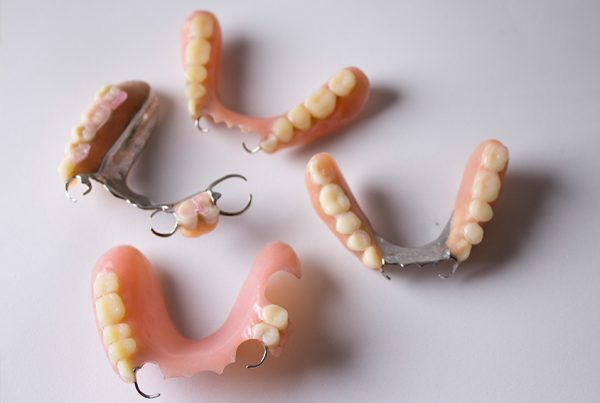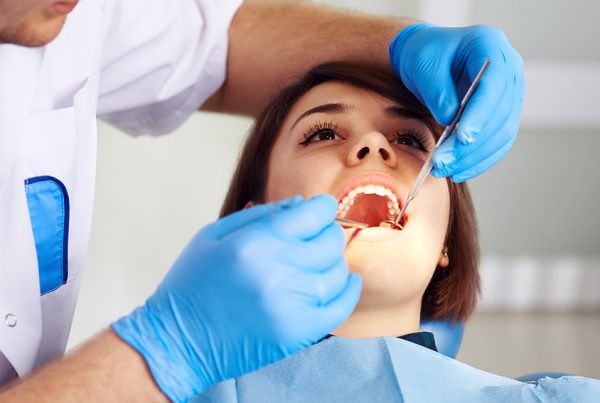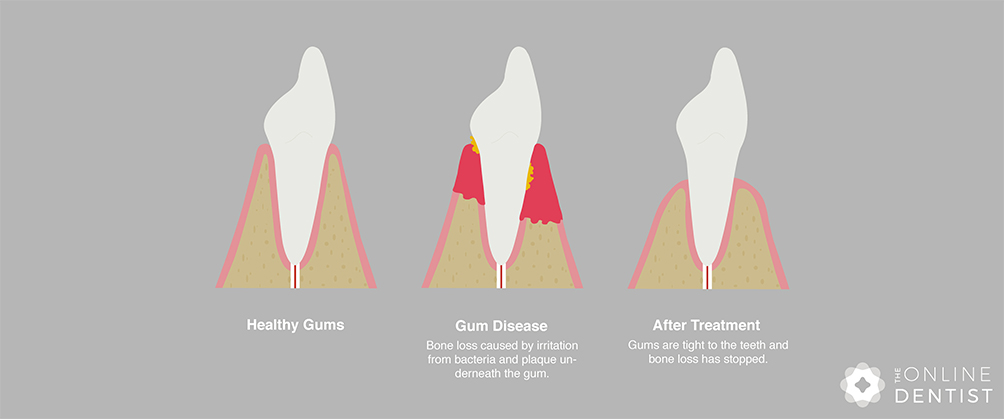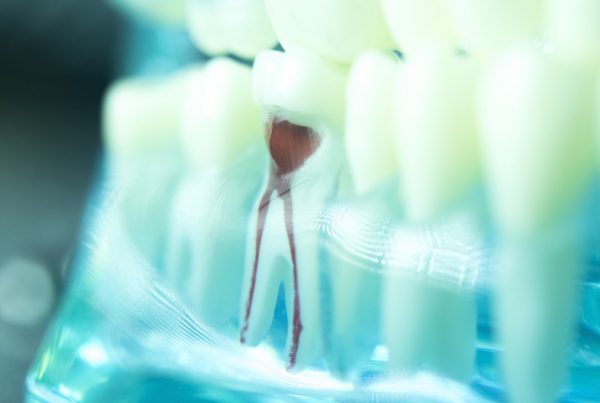Gum disease is when bacteria have got underneath your gums and are damaging the supporting tissues of your teeth. If you get rid of the bacteria, you’ll stop the damage. So it comes down to cleaning. But because the bacteria are out of the reach of your toothbrush, you can’t do it alone.
Professional cleaning will involve gently cleaning below the gum line, flushing away bacteria and removing any hard tartar build up that may be under the gum. This will be done with a range of bits of kit that include fine powered and hand operated instruments. It’s generally best to have the affected areas numbed first because it can be quite cold and sensitive otherwise.
The idea is to try and disinfect the whole of your mouth as effectively as possible to get rid of the offending bugs. Sometimes, your dentist may have to prescribe you antibiotics after the treatment to help finish off as many bacteria as possible. This tends to be used in more aggressive forms of gum disease, when the support around your teeth is being eroded away very quickly.
After treatment
After that, it’s down to you. Once your mouth has been thoroughly cleaned, the long term success of the treatment is in your hands. If you, as the patient, are able to keep your teeth perfectly clean, then you are going to keep the bacteria off your teeth, prevent the disease progressing and maintain your teeth for much longer.
If you are not able or willing to maintain things after the treatment, then bacteria will reinfect the areas that have been cleaned and the process will start again; bacteria irritating the support to your teeth and that support being slowly eroded away until the teeth are lost.
It is so important that your cleaning is as perfect as possible after gum treatment. If it isn’t good enough then the treatment won’t work.
Alternative treatments
The alternative to treatment of the gum disease is extraction of teeth. This, of course, would not be most peoples first choice and the disease must have become quite advanced for this to be considered. But for teeth which have been severely effected, this may be the best option. Sometimes, getting rid of a hopeless tooth that is wobbly and uncomfortable is a really good idea. These wobbly, hopeless teeth can act like little safe havens for bacteria. They may be too tricky for you and the dentist to clean. Bugs can stay there safe and sound until they decide to move out and explore different areas of your mouth to infect other teeth.
Benefits and Risks
The benefits of treating gum disease are that you halt the progress of the disease and try to maintain the teeth. You cannot get the gum and bone back that has been lost by disease but you can stop the situation getting worse.
Maybe I shouldn’t say that you cannot get the gum and bone back. I should say that it is highly unlikely. In certain situations, it is possible to regenerate a small amount of lost bone or gum but it is complex treatment and will only work in quite specific circumstances. It is often only something that a gum specialist would be able to provide for you. It will almost certainly involve a minor surgical procedure.
Other benefits of treating gum disease include that your teeth may feel firmer if they were moving and your breath may be fresher.
After gum treatment, your mouth and gums are likely to be sore for a few days. Normal painkillers that you would take for a headache are best for this. You may feel that your teeth are a bit more sensitive to temperatures for a few days. Something like a sensitive toothpaste is ideal here.
If you get some swelling after gum treatment, something like an ice pack in a tea towel applied to the area can help a great deal with keeping the swelling down.
As your gums heal they will hopefully go from being swollen and inflamed to being less swollen and much tighter to your teeth. For this reason, you may notice your gums shrink back after treatment, leaving little gaps between your teeth that will be easier to clean.
Good news
I pinched this last bit from another article but it’s important…
The great thing about gum disease (I know this is a strange start to a sentence) but the great thing is that you, as a patient, have a huge amount of control over it. If you spend the time in your daily routine to get your mouth and teeth perfectly clean at least twice a day, using advice from previous chapters, you will be able to halt the disease yourself.
You are going to need some professional cleans at the start and then further visits every few months to maintain things. However, ultimately the success of the treatment comes down to you and how motivated you are to save your teeth. So from that point of view, it’s fantastic. You are in control.
Advice for patients after gum disease treatment
Following treatment of gum disease with your dental professional, there may be some discomfort, especially after deep cleaning. Over the following weeks, you may notice some changes in your mouth. We have the following advice.
PAINKILLERS
It is difficult to predict the degree of discomfort you will experience. It can sometimes be helpful to take some painkillers before the anaesthetic wears off and whenever necessary after that. Take whatever you would normally take for a headache.
SWELLING
Some swelling may occur. This usually starts to subside after one day. Placement of an ice pack in the first hours after treatment is likely to reduce the swelling. Place the ice pack on the outside of the face for about 30 minutes per hour the evening after treatment.
TOOTH BRUSHING
Start cleaning again the next day. This should include cleaning with interdental brushes.
LUKEWARM SALT WATER
Wait at least one hour after you have eaten or brushed your teeth before using the lukewarm salt water to bathe your gums. Do not rinse or gargle. Hold the water in your mouth for one minute and then spit out. Repeat this twice a day for a week.
ANTIBIOTICS
Sometimes your dentist may recommend antibiotics alongside you gum treatment. If recommended, please take them as advised by your dentist.
DIET
It would be wise to have a normal lunch and dinner. This is especially the case if you are having pain killers and antibiotics. Avoid very hot or very cold food or drink during the first 24 hours.
DAILY ROUTINE
Strenuous exercise should be avoided for one day. Take it easy and do not overexert yourself.
SMOKERS
Smokers should avoid smoking for at least one week after treatment. Smoking is likely to compromise healing of your gums.
CONCERNS
If you have concerns regarding your mouth or the treatment you have received, it is best to contact the practice that provided your treatment.
Keep updated with the Online Dentist newslettersign up today
Recent Articles
 A denture is a false tooth or teeth on a plate. They are not fixed in place and can be taken in and out. They are generally the easiest way...
A denture is a false tooth or teeth on a plate. They are not fixed in place and can be taken in and out. They are generally the easiest way...
 Gum disease is when bacteria have got underneath your gums and are damaging the supporting tissues of your teeth. If you get rid of the bacteria, you’ll stop the damage....
Gum disease is when bacteria have got underneath your gums and are damaging the supporting tissues of your teeth. If you get rid of the bacteria, you’ll stop the damage....





